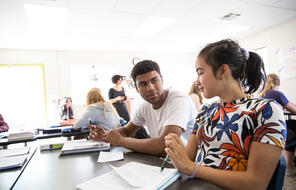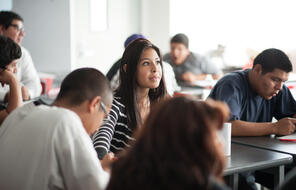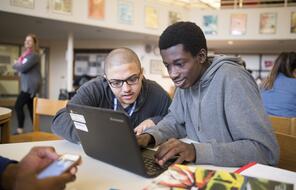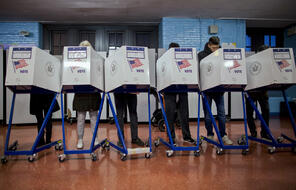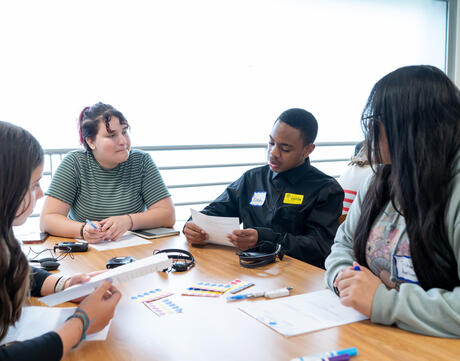
Understanding Political Polarization
Subject
- Civics & Citizenship
- Social Studies
Grade
6–12Language
English — USPublished
Get it in Google Drive!
Get everything you need including content from this page
Get it in Google Drive!
Get everything you need including content from this page
Overview
About This Activity
The United States has become increasingly polarized and divided along political lines over the last few decades on a state and national level. In this 20-minute activity, students will explore the first half of the Political Polarization in the United States explainer, which focuses on what political polarization is and its causes. Students will then make connections between the reading and what they already know about divisions or polarization in our society; they will reflect on ways that the explainer extends or broadens their thinking; and they will consider what new questions it raises.
Activity Material
- Explainer: Political Polarization in the United States
- Handout: Connect, Extend, Challenge Chart
How to Implement This Activity
- Prepare Students for the Activity
Explain to students that the United States is made up of many diverse communities that differ in identity, experience, and perspectives. Note that the US has become increasingly polarized and divided along political lines over the last few decades on a state and national level. This is affecting communities across the country. 1 For instance, 3 in 10 Americans noted that political polarization was a top issue facing the country in 2022. 2
If you taught Activity 1: Exploring Community, you can reference your discussion about how communities often include people with different political perspectives. If you did not teach Activity 1, you can read the following quote about community with your students:
“Communities are not built of friends, or of groups with similar styles and tastes, or even of people who like and understand each other. They are built of people who feel they are part of something that is bigger than themselves: a shared goal or enterprise, like righting a wrong, or building a road, or raising children, or living honorably, or worshiping a god. To build community requires only the ability to see value in others, to look at them and see a potential partner in one’s enterprise.” —Suzanne Goldsmith, author
- Introduce Political Polarization
Then ask students if they have ever heard of the phrase “political polarization.” Encourage students to brainstorm words, phrases, or brief ideas that they associate with political polarization. You can list these on the board.
Next, share a definition of political polarization: Political polarization is the movement of political views and actions away from the center and toward more extreme views and policies. 3
Ask students to consider what it means for political polarization to be “extreme” (i.e., very great or to a high degree) in the United States and how they think that differs from individuals within a community holding different views or different political perspectives. - Reflect on Political Polarization and Its Causes
Then share the Political Polarization in the United States explainer with students. Ask them to read sections A, B, and C of the explainer, which explore what political polarization is and its causes. As they read, ask students to take notes, following the Connect, Extend, Challenge protocol:- Connect: How do the ideas and information in this reading connect to what you already know about divisions or polarization in our society
- Extend: How does this reading extend or broaden your thinking about divisions or polarization in our society
- Challenge: Does this reading challenge or complicate your understanding of divisions or polarization in our society? What new questions does it raise for you?
If you’d like, you can ask students to use the Connect, Extend, Challenge Chart to collect and organize their connections, extensions, and challenges while reading. - Discuss Connections, Extensions, and Challenges
When they are done, ask students to pair up with a partner and share their reflections. Give each pair of students three sticky notes. Ask them to choose one connection, one extension, and one challenge to write down on separate sticky notes. They will then place the notes on three different pieces of chart paper around the room, labeled Connections, Extensions, and Challenges. Ask students to walk around the room and read the notes once they have all been placed. - Debrief As a Class
Afterward, ask students to share what they noticed and what stood out to them from their conversation with their partner and from the sticky notes. Summarize together what connections the class made, how the reading extended or broadened their understanding of political polarization, and what questions were raised. If time allows, answer any questions that arose or let students know when you will cover them.
- 1 Krysten Crawford, “ The roots of legislative polarization: How state elections are producing a more extreme pipeline of political candidates,” Stanford Institute for Economic Policy Research (SIEPR), February 28, 2022.
- 2Geoffrey Skelley and Holly Fuong, “3 In 10 Americans Named Political Polarization As A Top Issue Facing The Country,” FiveThirtyEight, June 14, 2022.
- 3Jeremy Stoddard and Diana E. Hess, “The Effects of Political Polarization on Social Studies Education and What We Should Do,” Social Education 88 (1), January/February 2024: 11–23.
Unlimited Access to Learning. More Added Every Month.
Facing History & Ourselves is designed for educators who want to help students explore identity, think critically, grow emotionally, act ethically, and participate in civic life. It’s hard work, so we’ve developed some go-to professional learning opportunities to help you along the way.
Exploring ELA Text Selection with Julia Torres
On-Demand

Working for Justice, Equity and Civic Agency in Our Schools: A Conversation with Clint Smith
On-Demand

Centering Student Voices to Build Community and Agency
On-Demand





